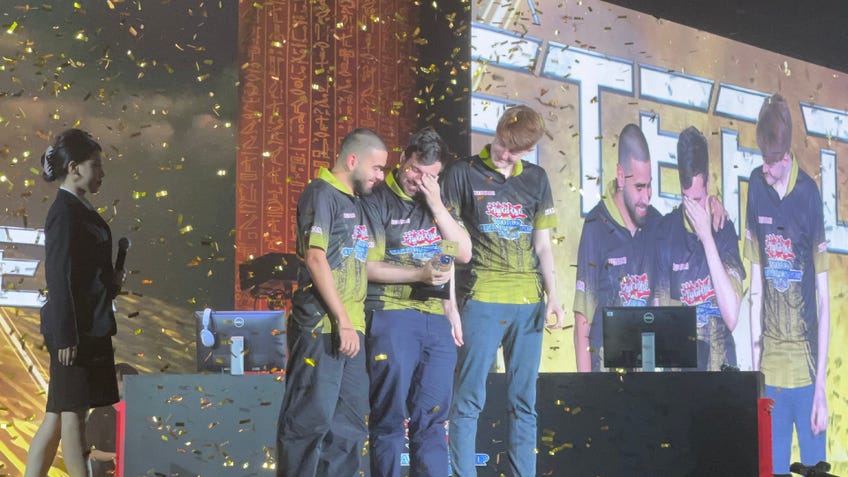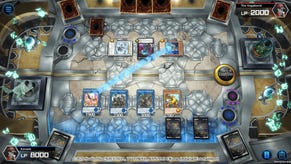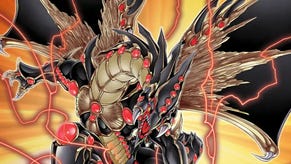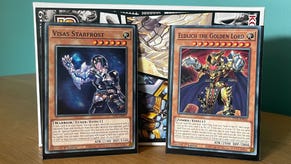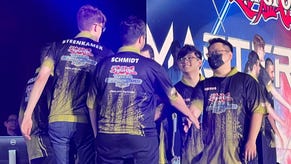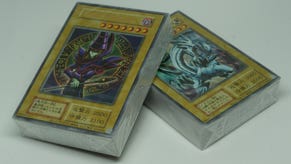A weekend of celebration, competition and community among Yu-Gi-Oh!’s top players at the first World Championships in four years
Meeting with hopefuls - and eventual champions - ahead of their appearance on the card game’s grandest stage.
A world of competition. National and international championships of thousands of players. All whittled down to a field of under 30 of the very best pros from around the world. Every year, only a few select duelists from each region are given the privilege of competing at the Yu-Gi-Oh! World Championships, making the list of players who’ve ever competed at these events an exclusive club consisting of some of the very best to ever play the trading card game.
From my younger days playing Yu-Gi-Oh! to my time today as a reporter on the game, I’ve never had the opportunity to attend the World Championships in person. Failing in regional tournaments was about the closest I ever got to making it to the prestigious invite-only pinnacle of the game, so it’s not like I can even claim the opportunity slipped through my fingers, either. The child in me would have loved to be there, but the World Championship games on the Game Boy Advance were about the closest I was ever going to get.
Then we heard news that the championships would be returning to Tokyo on August 5th and 6th of this year, with the added excitement of this event representing the grand return of the format for the first time in the post-COVID era. A championship on my doorstep? I was never going to pass up on the opportunity!
To top it all off, this year promised to be one of the most exciting championships to date; for the first time there’d be not one or two, but three champions, as duelists not only fought for glory in the TCG and Duel Links, but in Master Duel for the first time in a special three-vs-three championship format. After being starved of official competition since 2019, this would also crown the TCG’s first world champion in four years, with a game that had evolved dramatically in the years since Kosaka Kouki lifted the trophy four years ago.
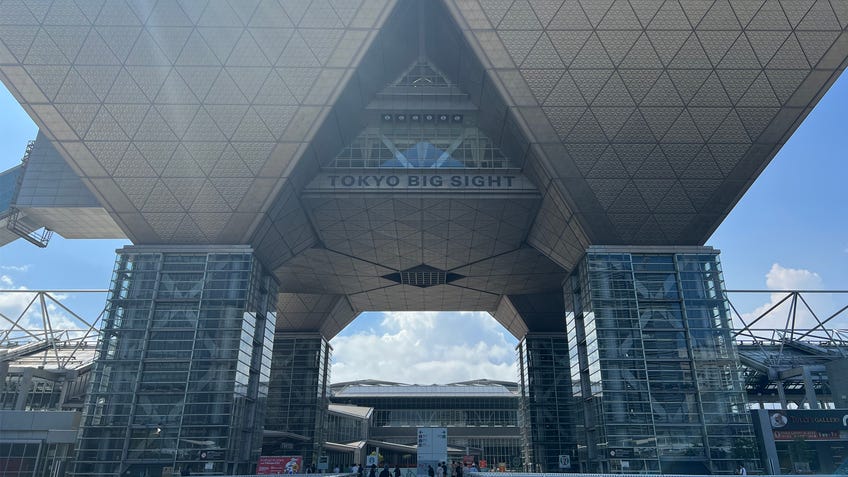
The night before the competition officially kicked off, I had a chance to meet the hopefuls in a far more relaxed environment at their hotel. Players of all three formats were here, alongside judges who gave insight into what to expect from the event. Everyone had given years of their life to the game, and this was the platform for them to showcase that effort to the world.
Only the most qualified judges were chosen to aid in judgement calls during the event, in part because of the high-stake situations, unique nature of the format and the need to cross language barriers in order to ensure correct decisions are made. Language barriers had already factored into judge Moritz Astfalk’s experience judging EU events with multiple languages under one roof, but such considerations become more important on such a grand stage. Especially when regional differences also come into play.
In Master Duel, you have to plan against all different kinds of strategies, because everyone is forced to bring six different things.
“While the language and culture barrier is the biggest aspect [in differentiating Worlds from other events], you actually get a lot of that back home in Europe,” Astfalk explained. “Sometimes there are people who only speak the native language, so in Europe we have judges of all languages on staff for the big events. We also do the same here at the World Championships, so when there's a language barrier, we get someone to translate. The judge still leads the conversation and makes sure that everyone is on the same page.
“Sometimes while sorting situations Player A may say, ‘This is the way it works,’ and the other player may say, ‘No, this is what I know from my native part of the game.’ It becomes important to tell them it’s about the ruling. Ultimately it’s like questions over intricate rulings where the judge has the final say for that tournament, so it may be escalated to a head judge to make the final call.’
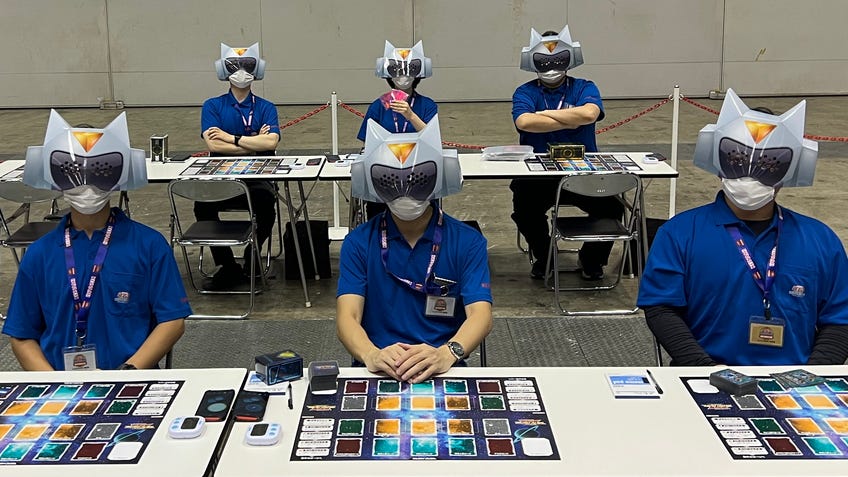
Players come from all around the world with different levels of experience for this event, each with its own metagame. Before his team were crowned world champions over the weekend, I spoke with Joshua Schmidt of Team snipehunters. An experienced TCG player, he jumped into Master Duel and qualified for this event after becoming invested in the digital game thanks to its shared rulesets under a different card pool.
For competition, Master Duel is unique for being a three-on-three competition, with each player bringing two decks playing best-of-nine matches; cards are restricted to three copies across all six decks, except for three designated ‘share cards’ which are limited per-deck rather than per-team. These rulings force a wider variety of decks to compete.
“The most interesting part about the team thing is that we have to bring decks together,” Schmidt said. “Normally in the trading card game, you bring one deck - the one you think is the best deck - and you have to expect to face all the other decks that are currently popular. Here you have to plan against all different kinds of strategies, because everyone is forced to bring six different things.”
There were nerves for Schmidt, but confidence and calm that comes from prior Worlds experience and confidence in their work. As the person who would lift the trophy on the world stage 48 hours later, that confidence was to be rewarded.

The biggest excitement was inevitably centred on the TCG. It was the longest-running event, and a number of players were being favoured to win. Much excitement surrounded Jessica Robinson, not only for being the first woman to qualify for the World Championships but for her record European triumph with the Rikka Sunvalon deck. She brought the deck again to Worlds and ended up with an impressive Top 8 finish, having spoken to us with confidence the night before her first experience on the biggest of stages.
“Worlds specifically is a very different preparation style to normal events,” Robinson noted with an air of calm. “It’s all speculation and what we predict, so for me my mindset is not overthinking it.”
Worlds specifically is a very different preparation style to normal events. It’s all speculation and what we predict, so for me my mindset is not overthinking it.
An air of confidence while speaking to a journalist is not always going to match the reality of what’s going on inside someone’s head. For many of these players this was their first time reaching the World Championships, and duelists who reached this stage before had felt the pain of defeat. Nerves are inevitable. But ultimately, players wanted to have fun; many were just glad to catch up with their fellow competitors or to have the chance to meet one another for the very first time.
Besides, that was for the following morning. Arriving at the behind-closed-doors venue near the Tokyo Big Sight used to house the first day of competition, the jovial nature of the night before was replaced by silence. Every player in the room was experienced at competing at the very highest level of major tournaments around the world with intimate knowledge of the game.
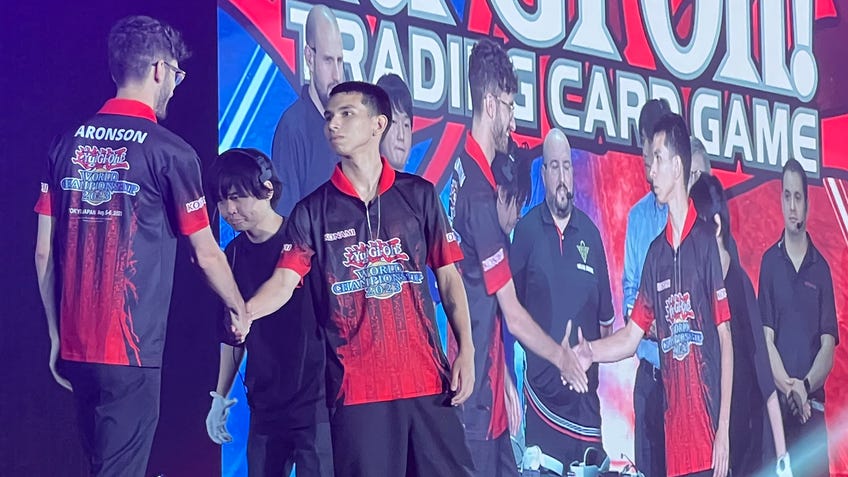
Inviting 28 of these talents into one room brought with it the weight of expectation on their respective journeys to Tokyo. Many had won competitions with thousands of entrants to be there; besides the raised stakes, that’s going to feel different when you’re suddenly in a competition with fewer players than the average English classroom.
Beyond our brief glimpse at the start of play in round one, entrance to the duel room was strictly forbidden, limiting updates to glancing at streams and fleeting chances to speak to players between rounds. If tension were visibly high in round one, win or lose, many calmed with their first match out the way until the final rounds of Swiss approached, all just embracing the joy of being in the room where it happens.
Shortly after qualifying for Top 8, Santiago Marín López found some time to speak about their preparation for the event and what they’ve appreciated about the opportunity to compete, revealing the unique complexities of a Worlds format frozen in time with a unique banlist.
“I tried to pick 10 decks that I think were good under the banlist, but we didn't know [at first] if Dueling Nexus was going to be allowed,” they said. “If that was the case, the tournament was going to be totally different - because with Dueling Nexus a lot of decks [are] better. Once I discovered that it was not going to be allowed, the choice was very easy, because we were already testing for that.”
Of course, a Top 8 - and eventually Top 4 - finish is a nice bonus. “It has been very exciting to play against the OCG players,” López added. “They play very differently. They do different choices than what we play in the TCG - so for me that’s been really exciting.’
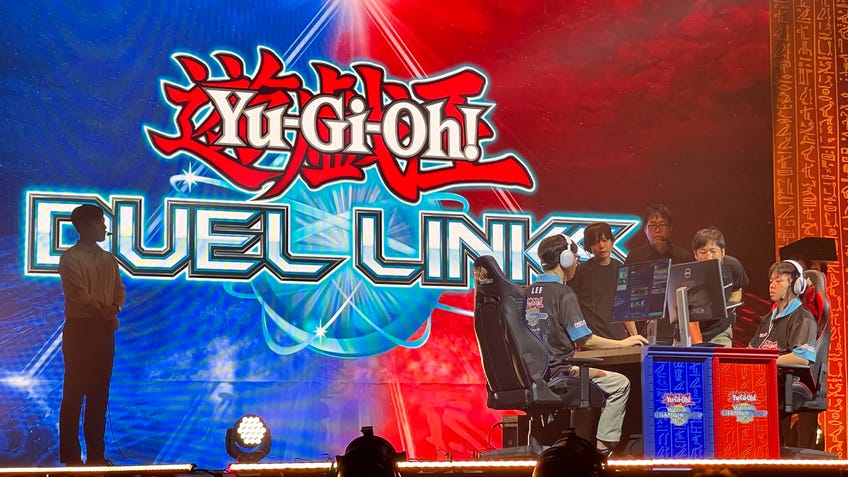
So, 28 players were whittled down to just eight, with the surprising news that no OCG players were able to reach the Top 8 stage. Alongside eventual world champion Paulie Aronson and fellow finalist Juan Mateo Augusto Renteria Pastor, Jeremy Taeron Mitchell, Santiago Marin Lopez, Gabriel Soussi, Jessica Robinson, Steven Hamilton Santoli and Enzo Maximiliano Fiallos Velasco qualified from Europe, South America and North America.
It showcased the strong diversity of the format, as even without decks like Tearlaments and Branded Despia piloted by the OCG players eliminated, the Top 8 still included five different decks, from Mathmech and Rikka Sunvalon to Tenyi Swordsoul and Vanquish Soul, and Aronson’s eventual winning deck, Dragon Link.
While the TCG remained the ultimate draw, some of the loudest roars from the crowd and biggest excitement came during Master Duel matches.
After Top 8 was played that same night, we went into Top 4 the following morning on finals day, when the public would have their chance to meet the champions and watch the finals unfold. While Top 4 was once again played at the behind-closed-doors venue from the day before, the finals moved to their grandiose home at the heart of the impressive Tokyo Big Sight convention hall, rented out to play host to a large stage and public events area for attending fans.
The public area promised a different vibe to that seen at other international events, with card vendors replaced exclusively by Konami’s own merchandising store handling card sales and the distribution of the exclusive playmats and promotional items sold for the event. Elsewhere, you could duel instructors - dressed for the occasion as characters from the anime - for the chance to win World Championships card sleeves, or even take on competitors from the event in TCG, Master Duel or Duel Links matches for similar prize offerings. There was a free area for trading, a team battle area and an area for Rush Duel battles.

While Rush Duel remains excluded from the World Championships, due to its exclusivity to Korea and Japan, morning pre-finals events crowned their own champion in the alternative format. A smaller stage set up within the side event hall played host to the Galaxy Cup finals in both Dragon Duel and general competitions. It was notable to see many fans attending the event gravitate to the area early on in the day in preparation, generating a great deal of excitement for a mode that could serve as a precursor for the future of the game - especially now that we know the game will soon reach English markets via Duel Links.
Even this felt dwarfed by the spectacle of the finals stage, with the early afternoon kicking off the opening ceremony with an exhilarating musical performance transposing classic Yu-Gi-Oh! anime tunes to traditional Japanese instruments like the koto and taiko drums. It was thrilling, raising the excitement in the venue before competition got underway.
The TCG finals felt like a true return for the World Championships.
Of the three competitions, Duel Links was the one I felt least familiar with going into the event - and I wasn’t alone in this. Players in other competitions admitted that their time at Worlds made them more interested in Duel Links after seeing how engaging and exciting finals matches could be, and you can understand why when in the room. For all some may dismiss the mode as being little more than a simplified mobile game minimal to the ‘real thing’, the shrunken board shifts the tactical considerations into the hand and becomes about optimising the available space to rush the field and overwhelm the opponent.
The same could be noted for the Master Duel competition, elevating the traditional TCG rules with the flashy visuals possible within the video game. Different banlists ensured the matches weren’t a mere repeat of other formats, allowing other decks to rise to the surface like Runicks. Indeed, while the TCG remained the ultimate draw, some of the loudest roars from the crowd and biggest excitement came from the intricate chain links executed by experienced players showcasing the depth and strategy in a format that’s easy on the eye for newcomers and long-time players alike.
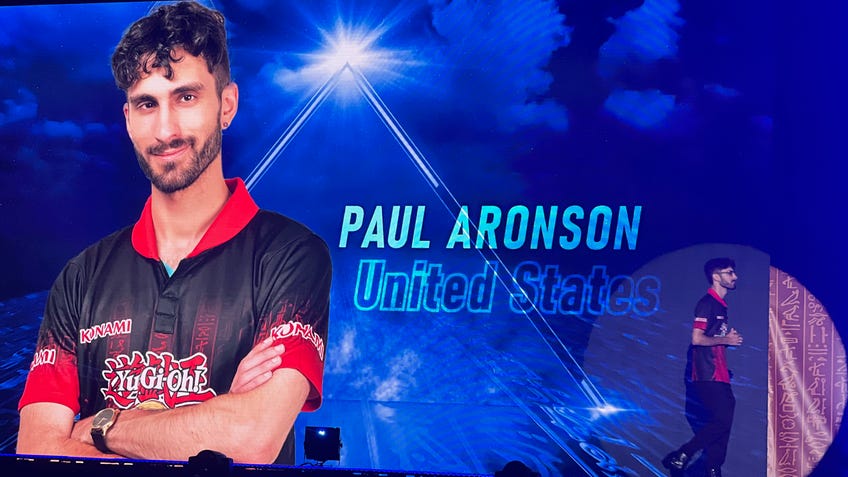
As our TCG players entered the stage, the crowd was electric. Both duels that led to Paulie Aronson’s victory were tightly-contested and grinding affairs, with Aronson admitting afterwards that mistakes almost cost him the match of his career. It takes skill from both players to create as thrilling and engaging a matchup as this. It felt like a true return for the World Championships watching this matchup - a reminder of what has been missed in recent years and what is to come in the future, with one of the most charming victory speeches I’ve seen.
No matter whom we spoke to at the end of two gruelling days of competition, no player felt truly upset about the experience. Renteria Pastor was just excited to have made it so far and remained upbeat shortly following the final. “[This weekend] was like a dream come true,” he explained. “I started playing the game when I was 15, and I used to print my own cards. My local store helped me a lot as I was growing up, and it was like they adopted me.
“When I got here, I felt like a child who just got out of his house for the first time, you know? I have a better perception of what Yu-Gi-Oh! actually means, it’s been great.”
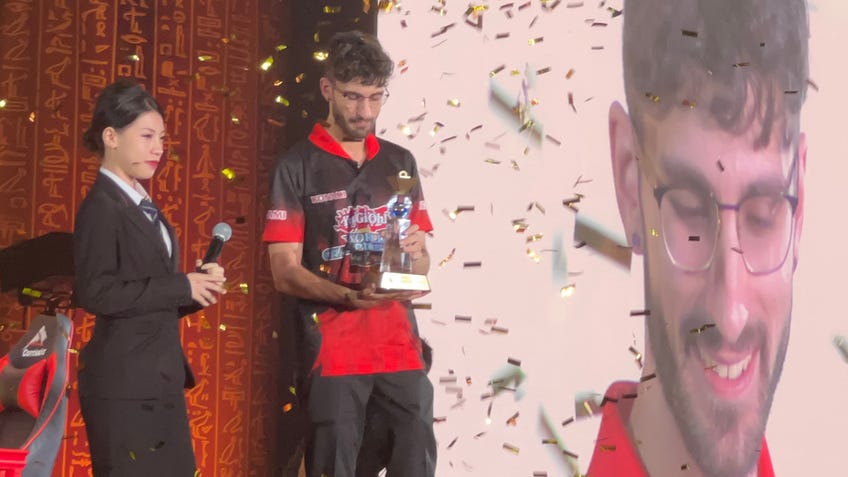
A smile wouldn’t leave my face as I left the event that night to head home. I thought about my own history of the game. A kid playing in locals and winning a few events but never pushing beyond that, drifting in and out of the game before returning with a flourish in recent years even as the move that brought me to the doorstop of these games forced me to part with much of my personal collection. Digital mediums for the game became my way of remaining in touch with this passion that brought me so much - and now to the biggest stage of all to meet and support the best players in the game. This was an event celebrating them, and not a single player can say they let themselves down or failed to showcase their talent at reaching such a prestigious event.
As quickly as the big event is over, a new competitive season begins. This past weekend saw the first events for the 2024 competitive season, with the goal for all players being to replicate the achievements of these players on the biggest stage. Once I returned home, I opened a few packs of my own. If I’m going to join them, I have to start somewhere, right?
